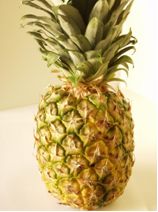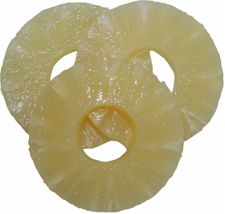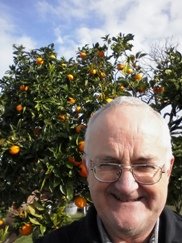Pineapple: Nutrition Facts - Health Benefits - Origins - Consumption
|
|
|
Contents
- Nutrition Facts: Vitamins, minerals and phytochemical components
- Health Benefits: Medicinal uses based on scientific studies
- Geographic origin and regions grown
- Common consumption today
- History of consumption
- Bibliography
I first ate fresh pineapple in Hawaii many years ago, so yummy. Unfortunately I had too much and the acidity caused a rash around my mouth for a day or two. Since then I take the opportunity to eat them fresh whenever I can, including in Tahiti and Queensland. They taste so different when fresh compared to store bought fruit, and the juice is great!
Nutrition Facts: Vitamins, Minerals and Phytochemical Components
They contain a large percentage of vitamins C and manganese. They contain smaller amounts of B1, A, B6, E, copper, bromelain, and dietary fiber (1).
Health Benefits: Medicinal Uses Based on Scientific Studies

Bromelain is a proteolytic enzyme found in them that breaks down protein in food and promotes digestion (3). For this reason, the juice is often used as a meat tenderizer and made into marinades.
Studies also suggest that bromelain has anti-inflammatory properties (3). They are a good source of manganese (91% DV in a 1 cup serving), as well as containing significant amounts of Vitamin C (94% DV in a 1 cup serving) and Vitamin B1 (8% DV in a 1 cup serving) (5), (6).
Some have claimed that it has potential benefits for the treatment of some intestinal disorders while others claim that it helps to induce childbirth when a baby is overdue.
The root and fruit itself are either eaten or applied topically as an anti-inflammatory agent and as a proteolytic agent (3), (5), (6). It is traditionally used as an anti-helminthic agent in the Philippines (4). A root decoction is also used to treat diarrhea.
Geographic Origins and Regions Grown
It was originally grown in South American and today is grown worldwide. Southeast Asia is the world’s leader in the production of the fruit.
History of Consumption

Charles II was presented with the first one that was grown in England. This can be seen in a 1675 painting by Hendrik Danckerts. It spread from its original area in central South America through cultivation and by the time of Christopher Columbus (1492) and it grew throughout South and Central America, southern Mexico, and the Caribbean (West Indies).
Columbus may have taken a sample back to Europe. The Spanish introduced it in the Philippines. It was introduced during the early 19th century in Hawaii and Guam as the first commercial plantation in 1886.
The fruit was successfully cultivated in European hothouses and pits during the beginning of 1720. The most common varieties now include: Pernambuco, Red Spanish, Smooth Cayenne, Hilo, St. Micheal, Natal Queen, and Kona Sugarloaf. Smooth Cayennes are usually the commercially available canned variety (1).
Cultivation in the USA began during the early 1900s in Hawaii. The famous brand names “Dole and Del” were founded on the island of Oahu in 1901 and 1917. Another famous company, known as the Maui Pineapple Company was founded in 1909 when they started cultivation. (2).
The fruit (Ananas comosus) is a tropical plant that is probably native to Uruguay, Brazil, or Paraguay. The herbaceous perennial plant is tall (1-1.5 m) and has 30 or more trough-shaped and pointed leaves that are 30-100 cm long.
The plant is surrounded by a thick stem. It is a multiple fruit, meaning it has many, flowers arranged spirally along the axis and each flower produces a fleshy fruit that presses against adjacent fruits that are growing and form one fleshy fruit. The leaves of the Smooth Cayenne cultivar lack spines except at the leaf tip, but the Spanish and Queen cultivars have large spines along the leaf margins. They are the only bromeliad fruit in widespread cultivation (1).
Certain bat-pollinated wild fruit, members of the bromeliad family, do the exact opposite of most flowers by opening their flowers at night and closing them during the day; this protects them from weevils, which are most active during daylight hours.
Common Consumption Today
Most often eaten fresh, they can also be used to make juice, jams, jellies, salads, ice cream, cakes, and pies. They are also added to a variety of foods such as pizza and meats. Fruit slices are also placed on the rim of cocktail glasses, found in various mixed drinks, and combined with numerous fruits in multivitamin beverages.
Southeast Asia currently dominates the world’s production. In 2001, Thailand produced 1.979 million tons, the Philippines 1.618 million tons, and 1.43 million tons was produced between America and Brazil. The total production throughout the world in 2001 was 14.220 million tons.
The primary exporters of the fresh fruit in 2001 were Costa Rica, 322,000 tons; Côte d'Ivoire, 188,000 tons; and the Philippines, 135,000 tons. In commercial farming, flowering can be artificially induced and the early harvesting of the main fruit can encourage the development of a second crop of smaller fruits.
Bibliography
- California Rare Fruit Growers, Inc. (1996) Pineapple. Retrieved on October 23, 2007 from http://www.crfg.org/pubs/ff/pineapple.html.
- FactsAboutFruit.com. (2007) Pineapple. Retrieved on October 23, 2007 from http://www.factsaboutfruit.com/Pineapple.html
- Maurer HR. (2001) Bromelain: biochemistry, pharmacology and medical use. Cellular and Molecular Life Sciences, 58(9):1234-45.
- Monzon RB. (1995) Traditional medicine in the treatment of parasitic diseases in the Philippines. Southeast Asian journal of Tropical Medicine and Public Health, 26(3): 421–428.
- The Fruit Pages. (2007) Fruit Nutrition Facts: Pineapple, Raw. Retrieved on December 11, 2007 from http://www.thefruitpages.com/chartpineapples.shtml.
- The World’s Healthiest Foods. (2007) Pineapple. Retrieved on December 11, 2007 from http://www.whfoods.com/genpage.php?tname=foodspice&dbid=34
Disclaimer
Nutritiousfruit.com provides this website as a service. Although the information contained within the website is periodically updated, no guarantee is given that the information provided is correct, complete, and/or up-to-date. The materials contained on this website are provided for general information purposes only and do not constitute legal or other professional advice on any subject matter. Nutrtiousfruit.com does not accept any responsibility for any loss, which may arise from reliance on information contained on this website. The information and references in this website are intended solely for the general information for the reader. The content of this website are not intended to offer personal medical advice, diagnose health problems or to be used for treatment purposes. It is not a substitute for medical care provided by a licensed and qualified health professional. Please consult your health care provider for any advice on medications.
Didn't find what you were looking for? Search here...

Amazon Search Box:
Did you like this page?
|
|
|




